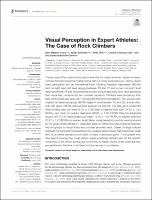Por favor, use este identificador para citar o enlazar este ítem:
https://repositorio.usj.es/handle/123456789/812
Registro completo de metadatos
| Campo DC | Valor | Lengua/Idioma |
|---|---|---|
| dc.contributor.author | Marcén, Noel | - |
| dc.contributor.author | Sanchez, Xavier | - |
| dc.contributor.author | Otín Mallada, Sofía Zaira | - |
| dc.contributor.author | Cimarras-Otal, Cristina | - |
| dc.contributor.author | Bataller-Cervero, Ana Vanessa | - |
| dc.date.accessioned | 2022-07-15T11:12:02Z | - |
| dc.date.available | 2022-07-15T11:12:02Z | - |
| dc.date.issued | 2022-07-14 | - |
| dc.identifier.citation | Marcen-Cinca N, Sanchez X, Otin S, Cimarras-Otal C and Bataller-Cervero AV (2022) Visual Perception in Expert Athletes: The Case of Rock Climbers. Front. Psychol. 13:903518. doi: 10.3389/fpsyg.2022.903518 | es_ES |
| dc.identifier.issn | 1664-1078 | es_ES |
| dc.identifier.uri | https://repositorio.usj.es/handle/123456789/812 | - |
| dc.description.abstract | The purpose of the present study was to examine the visual perception system in expert climbers through a psychophysical optical test in a cross-sectional study. Twenty-seven male participants with an International Rock Climbing Research Association (IRCRA) best on-sight lead skill level ranging between 18 and 27 and a best red-point level ranging between 18 and 29 completed a series of psychophysical optic tests assessing their visual field, visual acuity, and contrast sensitivity. Climbers were divided by their best red-pointed lead level, and, following IRCRA recommendations, two groups were created: an advanced group (IRCRA redpoint level between 18 and 23), and an elitehigh elite group (IRCRA redpoint level between 24 and 29). The elite group presented more training days per week (5.25 +-1.28), best on-sighted lead level (24.63 _ 1.92 IRCRA), and best red-pointed lead level (26.63 +- 2.56 IRCRA) than the advanced group (3.67 +- 0.91 training days per week, 19.50 +- 1.04 IRCRA on-sighted level and 20.67 +- 1.57 IRCRA red-pointed level). Better visual perception outputs were produced by the group of elite climbers in visual field tests; no differences were observed between the two groups for visual acuity and contrast sensitivity tests. Overall, findings indicate that best climbers performed better at the visual perception tasks that tested their visual field. Such better perception from best climbers is discussed given (1) the greater time they spend coercing the visual system during practicing climbing and (2) the specific complexity of the stimuli as they are confronted to harder routes where holds are less perceptible and the time to find best hold sequences is constrained. | es_ES |
| dc.format.extent | 8 p. | es_ES |
| dc.format.mimetype | application/pdf | es_ES |
| dc.language.iso | eng | es_ES |
| dc.publisher | Frontiers Media S.A. | es_ES |
| dc.rights | Atribución 4.0 Internacional | * |
| dc.rights.uri | http://creativecommons.org/licenses/by/4.0/ | * |
| dc.subject | Contrast sensitivity | es_ES |
| dc.subject | Expertise | es_ES |
| dc.subject | Visual acuity | es_ES |
| dc.subject | Visual field | es_ES |
| dc.subject | Visuo-motor development | es_ES |
| dc.title | Visual Perception in Expert Athletes: The Case of Rock Climbers | es_ES |
| dc.type | info:eu-repo/semantics/article | es_ES |
| dc.identifier.doi | https://doi.org/10.3389/fpsyg.2022.903518 | es_ES |
| dc.rights.accessrights | info:eu-repo/semantics/openAccess | es_ES |
| Aparece en las colecciones: | Artículos de revistas | |
Ficheros en este ítem:
| Fichero | Descripción | Tamaño | Formato | |
|---|---|---|---|---|
| Visual perception expert climbers.pdf | 1,26 MB | Adobe PDF |  Visualizar/Abrir |
Este ítem está sujeto a una licencia Creative Commons Licencia Creative Commons

